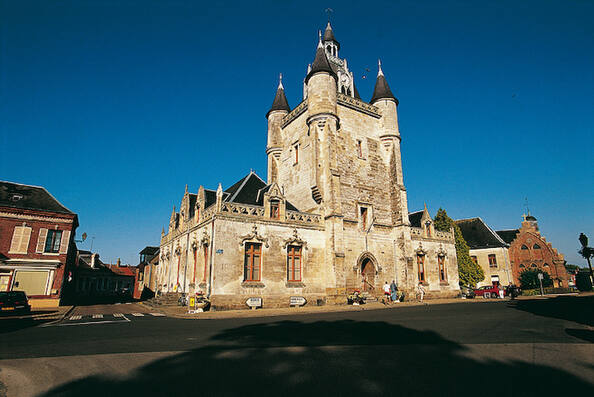Колокольни городов Бельгии и Франции
Belfries of Belgium and France
Twenty-three belfries in the north of France and the belfry of Gembloux in Belgium were inscribed in 2005, as an extension to the 32 Belgian belfries inscribed in 1999 as Belfries of Flanders and Wallonia. Built between the 11th and 17th centuries, they showcase the Roman, Gothic, Renaissance and Baroque styles of architecture. They are highly significant tokens of the winning of civil liberties. While Italian, German and English towns mainly opted to build town halls, in part of north-western Europe, greater emphasis was placed on building belfries. Compared with the keep (symbol of the seigneurs) and the bell-tower (symbol of the Church), the belfry, the third tower in the urban landscape, symbolizes the power of the aldermen. Over the centuries, they came to represent the influence and wealth of the towns.
Description is available under license CC-BY-SA IGO 3.0
Beffrois de Belgique et de France
Vingt-trois beffrois, situés dans le nord de la France, et le beffroi de Gembloux, en Belgique, ont été inscrits en 2005, comme une extension des 32 beffrois belges inscrits en 1999 sous le nom de Beffrois de Flandre et de Wallonie. Construits entre le XIe et le XVIIe siècle, ils illustrent les styles architecturaux roman, gothique, Renaissance et baroque. Ils constituent des symboles hautement significatifs de la conquête des libertés civiques. À une époque où la plupart des villes italiennes, allemandes et anglaises s’attachaient surtout à construire des hôtels de ville, dans une partie de l’Europe nord-occidentale, l’accent était mis sur l’édification de beffrois. Par opposition au donjon (symbole des seigneurs) et au clocher (symbole de l’Église), le beffroi, troisième tour du paysage urbain, représentait le pouvoir des échevins. Au fil des siècles, il est devenu le symbole de la puissance et de la prospérité des communes.
Description is available under license CC-BY-SA IGO 3.0
أبراج الكنائس في بلجيكا وفرنسا
أُدرج ثلاثة وعشرون برج كنيسة، في شمال فرنسا، وبرج كنيسة جمبلو، في بلجيكا، على قائمة التراث العالمي كمجموعة واحدة وكامتداد لأبراج الكنائس البلجيكية الإثنين والثلاثين المسجلّة عام 1999 تحت اسم ابراج الكنائس في فلندريا وفالونيا. شُيّدت هذه الأبراج بين القرن الحادي عشر والسابع عشر، وهي تعكس الأساليب الهندسية الرومانية والقوطية والباروكية وأساليب عصر النهضة. وتشكّل هذه الأبراج رموزاً معبّرة عن معركة الحريات المدنية. وفي وقت كانت غالبية المدن الإيطالية والألمانية والإنكليزية تتمسك ببناء دور البلدية، إنصبّ الإهتمام في قسم من شمال غرب أوروبا على تشييد أبراج الكنائس. وخلافاً للبرج الرئيس في حصن معيّن (رمز الأسياد الإقطاعيين) وقبّة الجرس (رمز الكنيسة)، فإنّ برج الكنيسة، وهو البرج الثالث البارز في المنظر الحضري، كان يمثل سلطة قضاة البلدية، ثم ما لبث أن أصبح، على مرّ القرون، رمزاً لنفوذ البلديات وازدهارها.
source: UNESCO/CPE
Description is available under license CC-BY-SA IGO 3.0
比利时和法国钟楼
这些钟楼建于11至17世纪,其中23座位于法国北部,32座位于比利时,它们共同展现了罗马、哥特式、文艺复兴和巴洛克式的建筑风格。钟楼在建立之初是公社通过宪章获得独立的标志,象征着自由。钟楼是城市景观中的第三种塔,可与要塞(封建领主,即封建地主的标志)和钟塔(教堂的标志)媲美,象征着贵族的权力。几个世纪以来,它们已逐渐成为城镇影响力和财富的象征。
source: UNESCO/CPE
Description is available under license CC-BY-SA IGO 3.0
Колокольни городов Бельгии и Франции
23 колокольни на севере Франции и колокольня в городе Жамблу в Бельгии дополняют 30 бельгийских городских башен, внесенных в Список всемирного наследия в 1999 г. как объект «Колокольни Фландрии и Валлонии». Колокольни были построены в ХI-ХVII вв. и относятся по своей архитектуре к романскому и готическому стилям, Возрождению и барокко. Это - яркие символы зарождавшихся гражданских свобод. В то время как в итальянских, германских и английских городах обычно предпочитали строить ратуши, в некоторых странах северо-западной Европы (Франция, Бельгия и Нидерланды) преобладали колокольни. Первоначально колокольни возводились в ознаменование независимости коммуны и получения ею хартии, как символ обретенной свободы. В отличие от замковой башни (символа синьора, т.е. – феодального властителя) и церковной колокольни (символа власти Церкви), городская колокольня – третья доминирующая в ландшафте города башня – символизировала влияние городских властей. В течение столетий такие башни олицетворяли мощь и богатство городов.
source: UNESCO/CPE
Description is available under license CC-BY-SA IGO 3.0
Campanarios municipales de Bélgica y Francia
Veintitrés campanarios situados en el norte de Francia y el campanario belga de Gembloux han sido inscritos en la Lista del Patrimonio Mundial en 2005, ampliando así el sitio formado por 32 campanarios municipales de Flandes y Valonia que ya figuraba en la Lista desde 1999. Construidos entre los siglos XI y XVII, estos campanarios son representativos de diversos estilos arquitectónicos –románico, gótico, renacentista y barroco– y constituyen símbolos muy significativos de la conquista de las libertades cívicas por parte de las poblaciones urbanas. En tiempos en que la mayoría de las ciudades italianas, alemanas e inglesas optaban por construir ayuntamientos, en esta región del noroeste de Europa se prefirió la construcción de campanarios municipales. Entre la tríada de torres que dominaban el paisaje de las ciudades, la del campanario municipal, emblema del poder de los concejales, se erguía frente a la del castillo señorial y la de la iglesia, símbolos respectivos del poder feudal y el eclesiástico. Con el correr de los siglos, llegó a simbolizar el poderío y la riqueza de cada municipio.
source: UNESCO/CPE
Description is available under license CC-BY-SA IGO 3.0
ベルギーとフランスの鐘楼群
登録の対象は、中世に起源をもつフランダース地方とワロン地方の24の鐘楼(アールスト、アントワープ、ブリュージュ、デンデルモンデ、ガン、ルーベン、イーペル、コルトレイクなど)である。現存する鐘楼の形態は多様であるが、その多くはタウン・ホールに、一部は協会に付属するもので、時を経てさらに都市の景観のなかに溶け込み続けてきた。後に、フランス北西部の23の鐘楼群とベルギーの鐘楼が追加され拡大登録。フランス、ベルギーオランダでは、市民憲章で自立・自由を象徴している鐘楼の建設を重視。鐘楼は市議会議員の権力を象徴している。source: NFUAJ
Belforten van België en Frankrijk
De 23 belforten in het noorden van Frankrijk en het belfort van Gembloux in België werden gebouwd tussen de 11e en 17e eeuw en tonen Romaanse, Gotische, Renaissance en Barok architectuurstijlen. Deze inschrijving op de Werelderfgoedlijst is een uitbreiding van de 32 in 1999 ingeschreven belforten van Vlaanderen en Wallonië. Waar Italiaanse, Duitse en Engelse steden er voornamelijk voor kozen donjons, (symbool van de (land)heren) of klokkentorens (symbool van de kerk) te bouwen, werd in een deel van Noordwest-Europa gekozen voor belforten. Belforten symboliseren de macht van de schepenen en de invloed en rijkdom van steden door de eeuwen heen.
Source: unesco.nl
